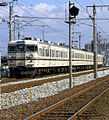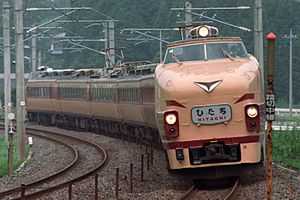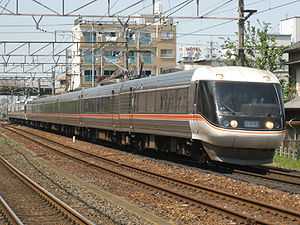115 series
| 115 series | |
|---|---|
|
3-car sets in "new Nagano livery" at Takao Station, March 2006 | |
| In service | 1963–Present |
| Constructed | 1963–1983[1] |
| Refurbishment | 1998– (for selected trains) |
| Number built | 1,921[1] |
| Operator |
JNR (1963–1987) JR East, JR West (1987–Present) Shinano Railway (1997–Present) JR Central (1987–2007) |
| Depot(s) |
Toyoda Nagano Niigata Fukuchiyama Okayama Hiroshima Shimonoseki Togura |
| Specifications | |
| Car body construction | Steel |
| Doors |
3 pairs per side 2 pairs per side (115-3000 series) |
| Maximum speed | 110 km/h (70 mph) |
| Traction system | Resistor control |
| Electric system(s) | 1,500 V DC overhead |
| Braking system(s) | Dynamic braking |
| Safety system(s) | ATS-S, ATS-P |
| Track gauge | 1,067 mm (3 ft 6 in) |
The 115 series (115系) is a DC electric multiple unit (EMU) train type developed by Japanese National Railways (JNR) and now operated by East Japan Railway Company (JR East), West Japan Railway Company (JR West), and the Shinano Railway.[2]
Operations
Following information was current as at mid-2009.
JR East
Currently used on the Agatsuma Line, Chūō Main Line (East Line), Hakushin Line, Jōetsu Line, Musashino Line, Ōito Line, Ryōmō Line, Shin'etsu Main Line, Shinonoi Line, Yahiko Line and the Echigo Line
Previously used on the Shōnan-Shinjuku Line, Takasaki Line and Utsunomiya Line.
JR West
Currently used on the Hakubi Line, Maizuru Line, Sagano Line, Sanin Main Line and the Sanyō Main Line
JR Central
Formerly used on the Minobu Line, Gotemba Line and the Tōkaidō Main Line. Sets owned by JR East currently operate on the JR Central Iida Line and Chūō Main Line (West Line).
Shinano Railway
Currently used on the Shinano Railway Line.
Variants
115-0 series
This is a cold-weather version of the earlier 113 series. The first examples were introduced from 1963 on the Takasaki Line out of Ueno.
115-300 series
Air-conditioned version introduced from 1973.
115-1000 series
Introduced from 1978 with increased seat pitch and improved cold-weather performance.
115-2000 series
Hiroshima,Shomonoseki and Shizuoka area version introduced in 1978. Specifications based on 115-1000 series.
115-3000 series
Two-door version introduced from November 1982 to replace 153 series EMUs on "Rapid" services in the Shimonoseki area.
115-3500 series
Former 117 series MoHa 117 and MoHa 116 two-door cars converted from May 1992 for use in the Okayama and Hiroshima areas.
115-6000 series
JR West 2-car sets converted in 1999 by building new cabs at one end of former MoHa (non-driving motor) cars.
Livery variations
-

Shōnan livery
-
"Suka" livery (March 2004)
-

Shinshū livery (Takasaki Station)
-

(Old) Niigata livery (Takasaki Station)
-
Second Niigata livery (Naoetsu Station)
-
New Niigata livery (Higashi-Niigata Station)
-

Yahiko Line livery (Niigata Station)
-

Setouchi livery
-

JR West refurbished livery (115-1600 series)
-
Hiroshima refurbished livery (115-3000 series)
-

Okayama and Hiroshima area livery (115-3000 series)
-

(Old) Fukuchiyama Line livery
-

New Fukuchiyama Line livery
-

Shinano Railway livery
References
External links
| Wikimedia Commons has media related to 115 series. |
- JR East 115 series (Japanese)
| |||||||||||||||||||||||||||||||||||||
| |||||||||||||||||||||||||||||||||||||
| |||||||||||||||||||||
| |||||||||||||||||||||||||||||






